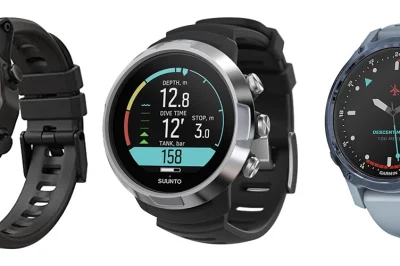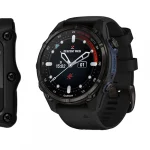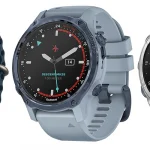Understanding the Role of Heart Rate Monitoring in Diving

Table of Contents
- Understanding the Role of Heart Rate Monitoring in Diving
- Unpacking the Myths: Heart Rate Monitoring in Diving
- Common Mistakes When Using Heart Rate Monitors in Diving
- Why Heart Rate Monitoring is the Future of Safe Diving
- Comparing Diving Computers: Which One Has the Best Heart Rate Monitoring?
- Enhancing Dive Safety: The Benefits of Heart Rate Tracking
- The Science Behind Dive Computers and Heart Rate Monitoring
- Senior Divers and the Importance of Heart Rate Data
Introduction
This blog explores the transformative integration of heart rate monitoring in diving computers, focusing on its impact on safety for Florida’s senior divers. Learn how this technology aids in making informed purchasing decisions for dive computers.
Understanding the Role of Heart Rate Monitoring in Diving
Benefits of Heart Rate Monitoring in Scuba Diving
Heart rate monitoring offers several critical benefits for scuba divers, enhancing safety and overall dive experience.
- Stress and Autonomic Nervous System (ANS) Tracking: Diving significantly impacts the ANS, influencing heart rate (HR) and heart rate variability (HRV). Typically, HR decreases during dives as the body adjusts to underwater conditions. Monitoring allows divers to quantify their stress response to factors such as cold water, exertion, or gas composition.
- Recovery Optimisation and Dive Safety: By tracking recovery times between dives, divers can set alarms for surface intervals, ensuring they eliminate excess CO₂ effectively. This practice is essential for improving endurance and expanding dive limits.
- Early Arrhythmia Detection: Increased ambient pressure and physical effort can stress the heart, leading to potential arrhythmias. Continuous heart rate monitoring enables early detection of irregular rhythms, crucial even for healthy divers unaware of underlying cardiovascular stressors.
Common Myths Debunked
Several myths surround heart rate monitoring in scuba diving, which can lead to misconceptions about its importance.
- Myth 1: Heart rate remains stable during dives. In reality, HR varies significantly due to underwater conditions, with documented spikes of up to 25 bpm in response to stress.
- Myth 2: Monitoring is unnecessary for healthy divers. While healthy divers may have increased parasympathetic activity, they can still experience sympathetic stress markers. Thus, monitoring is beneficial even for those who feel fine.
- Myth 3: HRV measurements are unreliable underwater. Although motion artifacts can occur, HRV analysis remains valid during steady dive conditions, providing insights into cardiovascular strain and recovery.
Practical Applications
Diving computers equipped with heart rate monitoring can offer practical applications:
- Frequency-domain HRV parameters: Monitoring parameters like ULF, VLF, LF, and HF can provide deep insights into autonomic balance, specifically indicating parasympathetic activation.
- Dive depth correlations: Different dive depths can show varied HRV patterns, underscoring the importance of tailored monitoring for dive conditions.
Utilising heart rate monitors bridges the gap between personal experience and objective cardiovascular assessments in scuba diving, ensuring a safer and more enjoyable experience.
Unpacking the Myths: Heart Rate Monitoring in Diving
When utilising heart rate monitors (HRMs) in diving, divers can easily make several common mistakes that compromise their safety and the effectiveness of the technology. Awareness of these pitfalls can greatly enhance the diving experience, particularly for seniors in Florida who are increasingly reliant on these devices for health monitoring.
Ignoring Motion Artifacts
Underwater environments are dynamic and often turbulent, causing physical movement that can interfere with the accuracy of HR readings from monitors. Adjustments while wearing gear or swimming can lead to erratic readings or false highs, such as a heart rate reported as 250 bpm, which is clearly unrealistic. This artifact results from the electrical signal distortions in motion, particularly during ascent or when adjusting equipment.
Overlooking Device Limitations
Many divers assume that their devices function underwater just like they do on land. However, some models, such as the Apple Watch Ultra, may disable heart rate monitoring when specific apps, like the Depth app, are active. It is vital for divers to understand the functionality of their equipment and ensure that heart rate tracking is enabled during dives, especially when regularly checking performance metrics.
Misapplying General Training Formulas
Using well-known heart rate training formulas, such as the 220-age method, can lead to inaccuracies in diving. These formulas are designed for a different context and do not account for the unique physiological responses that occur underwater due to factors like cold temperatures and dive-related stress. Divers are encouraged to establish individual baselines for their heart rate zones to ensure better safety and performance monitoring.
Failing to Consider Cardiac Lag
During intense physical activity or sudden depth changes, heart rate monitors may not instantly reflect the physiological demands being placed on the diver due to a phenomenon known as cardiac lag. This delay might result in misreading exertion levels, making it essential for divers to correlate their heart rate data with personal sensations of fatigue and stress to prevent overexertion.
Overreliance on HR Data Without Cross-Verification
Trusting extreme heart rate readings without secondary checks can lead divers into dangerous situations. It is recommended to cross-reference heart rate information with other key metrics such as dive duration and gas levels, as well as subjective feelings of exertion to validate the data collected by HRMs.
Neglecting Sensor Maintenance
Environmental factors play a significant role in the functionality of heart rate sensors. Saltwater exposure can accumulate biofilm, which may degrade performance over time. Therefore, regular cleaning and maintenance of the straps or sensors are critical to ensuring accurate readings.
Common Mistakes When Using Heart Rate Monitors in Diving
Smart Dive Computers and AI Integration
New-generation dive computers increasingly incorporate AI technology to analyse dive profiles in real-time, providing insights into breathing patterns, depth, and time. These systems now integrate biometric data, such as heart rate monitoring, to assess diver stress levels and optimise safety protocols. For instance, AI-powered software can sync with smartphones to generate detailed post-dive reports and adjust plans based on individual physiological responses.
Biometric Monitoring for Safety Efficiency
Heart rate tracking is emerging as a critical feature in advanced dive computers, enabling divers to detect early signs of fatigue or stress. AI-driven algorithms cross-reference this data with environmental factors (depth, temperature) to flag potential risks, enhancing situational awareness during dives. In Florida’s coastal diving hotspots, such tools can help mitigate environmental stressors like strong currents or thermal shifts.
Redundancy and Backup Systems
A growing trend emphasises dual-computer setups to ensure safety. Using two dive computers provides redundancy, offering fail-safe monitoring and minimising risks during complex or extended dives. This approach is particularly valuable in Florida’s wreck diving and technical environments where clear visibility and navigational accuracy are critical.
AI-Driven Dive Optimisation
Future systems aim to leverage predictions from machine learning to recommend personalised dive plans, avoiding overexertion or exposure limits. For example, AI could adjust decompression stops or advise on surface intervals based on real-time data from heart rate monitors and gas mixtures.
Lightweight and Travel-Friendly Gear
Florida divers benefit from compact, travel-efficient equipment as manufacturers prioritise portability. New materials and modular designs reduce bulk while maintaining durability, catering to divers frequenting destinations like the Florida Keys.
Collaboration with Underwater Robotics
Advanced robotics and underwater communication (e.g., text-to-speech devices) are being tested to enhance teamwork during dives. AI integration could enable real-time translations or hazard alerts, improving safety in multinational dive groups common in Florida’s dive tourism. These innovations position Florida as a hub for testing and adopting cutting-edge diving technologies, balancing safety, efficiency, and environmental stewardship.
Why Heart Rate Monitoring is the Future of Safe Diving
Top Recommendations for Diving Computers with Heart Rate Monitoring
For seniors seeking dive computers with heart rate monitoring in 2025, certain models stand out for their functionality, ease of use, and advanced features. The following options provide both safety and technological support tailored for older divers:
ScubaPro G2
This model is explicitly designed with adaptive heart rate monitoring, allowing it to adjust dive metrics in real-time based on the diver’s physiological feedback. This feature is particularly crucial for older divers, as it enables better management of exertion levels during dives. Despite limited detailed reviews, the ScubaPro G2’s focus on safety and usability makes it a strong candidate for seniors.
Garmin Descent Mk2i
The Garmin Descent Mk2i is a smartwatch-style dive computer that includes:
- Built-in heart rate tracking: As standard in most Garmin smartwatches, it effectively monitors heart rate during dives.
- Intuitive touchscreen interface: Simplifies access to crucial dive data and metrics, enhancing user experience.
- Rugged design: Its sturdy construction caters well to technical diving environments, ensuring durability.
Apple Watch Ultra
This device is ideal for tech-savvy divers, combining the functionality of a rugged smartwatch with dive-specific features. Key highlights include:
- Heart rate monitoring: Continuous tracking helps divers be aware of their cardiovascular status while underwater.
- Durable and water-resistant design: Engineered for extreme conditions, it’s perfect for both diving and everyday use.
- Familiar interface: Many seniors may find the Apple ecosystem easier to navigate, especially if they use other Apple products.
Choosing the right diving computer with heart rate monitoring can significantly enhance safety and confidence for senior divers. The ScubaPro G2, Garmin Descent Mk2i, and Apple Watch Ultra each offer unique features designed to meet these needs.
Comparing Diving Computers: Which One Has the Best Heart Rate Monitoring?
Heart rate monitoring is revolutionising the diving experience for senior divers, addressing the unique safety concerns that come with age. The integration of this technology not only enhances safety but also enriches the overall diving experience, providing divers with crucial data that can mitigate risks associated with underwater exploration.
Early Detection of Cardiac Stress
Monitoring heart rate is essential for identifying signs of cardiac distress. Research indicates that a significant portion of diving fatalities, approximately one-third, is attributed to cardiac events, which can disproportionately affect seniors due to preexisting heart conditions. Real-time heart rate tracking enables divers to recognise abnormal patterns and make timely adjustments to their dive plans, thus preventing potentially fatal situations.
Enhanced Stress Assessment via Heart Rate Variability (HRV)
Heart rate variability is a key indicator of autonomic nervous system function. In healthy individuals, diving stimulates parasympathetic activity, promoting a stable heart rate. However, seniors may lack this adaptive capacity, making HRV monitoring particularly crucial. By assessing HRV, divers can evaluate how their body is managing stress, allowing adjustments to diving intensity or duration as needed.
Workload Optimisation and Decompression Safety
- Assessing Physical Exertion: Higher heart rates are correlated with increased nitrogen absorption during dives. Utilising dive computers that adapt decompression algorithms based on heart rate data enhances safety by tailoring dive profiles.
- Avoiding Overexertion: Seniors can closely monitor their heart rate and reduce physical demand if certain thresholds are exceeded, thus minimising exertion-related cardiac strain.
Personalised Training and Fitness Management
Heart rate data empowers seniors to tailor their fitness regimes leading up to dives. By focusing on endurance training aligned with their heart rates, divers can better prepare themselves for the demands of underwater exploration while decreasing the risks associated with fatigue. This data-driven approach empowers divers to modify dive plans based on heart rate trends, ensuring a safer underwater experience.
Improved Incident Response
Real-time heart rate monitoring facilitates quicker responses to physiological changes. An immediate rise in heart rate alerts divers to potential health issues, enabling preemptive action before a problem escalates, thereby enhancing overall dive safety.
Technological Tools
Modern dive computers equipped with integrated heart rate sensors provide real-time feedback on physical workload and stress levels, making them invaluable for senior divers who wish to enhance their safety while diving.
Enhancing Dive Safety: The Benefits of Heart Rate Tracking
Dive computers represent a significant advancement in ensuring diver safety, operating primarily through sophisticated algorithms that manage decompression calculations based on real-time data. Their primary function is to calculate the nitrogen levels in a diver’s body, essential for avoiding decompression sickness, commonly known as “the bends.”
Core Function: Decompression Safety
These devices employ pressure sensors to continuously track a diver’s depth and the time spent at various depths. This data feeds into established decompression models such as the Bühlmann or PADI algorithms, which calculate the build-up of nitrogen in the body tissues:
- Depth & Time Tracking: Constant depth and duration measurement allows for accurate nitrogen loading assessments.
- No-Decompression Limit (NDL): This feature provides divers with information on how long they can safely remain at a depth before needing to perform mandatory safety stops as they ascend.
- Dynamic Adjustments: As the diver changes depth, the computer recalibrates limits in real-time, ensuring safety parameters adjust automatically, reflecting pressure and gas loading changes.
Hypothetical Heart Rate Integration
While specific studies related to heart rate monitoring and diving computers are limited, it’s conceivable that advanced models may incorporate heart rate tracking. Here’s how such functionality could enhance diving safety:
- Metabolic Impact: A higher heart rate often signals increased exertion, suggesting rapid nitrogen absorption. If a dive computer were equipped with this feature, it could adjust decompression estimates accordingly, mitigating risks associated with elevated physical activity during dives.
- Battery Life Considerations: Integrating heart rate sensors may affect battery durability, a crucial consideration for divers relying on long-duration dives.
- Current Limitations: Most entry-level dive computers primarily focus on depth and time, while heart rate monitoring is more prevalent in fitness technology.
Key Features vs. Dive Tables
| Feature | Dive Computer | Traditional Dive Tables |
|---|---|---|
| Real-Time Updates | Adjusts to depth changes automatically | Requires pre-dive calculations |
| Multiple Profiles | Caters to varying depths during a dive | Assumes static depth and time |
| Safety Margins | Utilises conservative algorithms for safety | Relies on fixed limits without adjustments |
The potential for integrating heart rate monitoring involves a degree of speculation, as it is primarily based on prevailing trends in wearables and fitness technology. Therefore, divers should verify a dive computer’s capabilities directly from the manufacturer or retailer before making a purchase decision.
The Science Behind Dive Computers and Heart Rate Monitoring
Heart rate data is vital for managing health and safety among senior divers. As divers age, the risk of cardiac-related events increases significantly. In fact, about one-third of dive-related fatalities are attributed to cardiac problems, particularly among divers over the age of 50. Among these, conditions like myocardial infarctions and arrhythmias can pose severe risks during diving activities, especially when physical exertion is involved, such as when navigating strong currents or managing buoyancy under stressful conditions.
Monitoring heart rate and heart rate variability (HRV) offers critical insights into a diver’s cardiovascular health. HRV assesses how well the autonomic nervous system (ANS) regulates heart function during dives. Under normal circumstances, a healthier autonomic response helps maintain heart rate fluctuations, but abnormal patterns may suggest stress induced by factors like cold exposure or exertive swimming. This is particularly relevant for senior divers who may lack the cardiovascular reserve necessary for recovery from physical stressors.
Practical applications of heart rate monitoring in senior divers include:
- Baseline HRV Monitoring: Establishing a baseline HRV can help identify older divers at risk due to underlying cardiac conditions.
- In-Dive Fluctuations: Real-time heart rate tracking can detect warning signs of arrhythmia or excessive strain, allowing divers to prioritise safety and abort dives if necessary.
- Post-Dive Recovery Analysis: Monitoring recovery patterns can indicate how well the cardiovascular system rebounds from the exertion of diving, which is crucial for senior divers.
In conclusion, heart rate data can serve as both a preventive tool to identify at-risk individuals and an incident response mechanism to diagnose acute stress during dives. Integrating heart rate monitoring technology within diving practices is an essential step toward enhancing safety and ensuring a better diving experience for seniors.
Senior Divers and the Importance of Heart Rate Data
Selecting the Right Dive Computer for Senior Divers in Florida
For senior divers in Florida, choosing the right dive computer is an essential step toward enhancing safety and enjoyment during underwater adventures. Key features to consider include readability, ergonomics, and integrated health monitoring capabilities such as heart rate monitoring.
Senior-Friendly Features
- Large Displays: A dive computer with a large, high-contrast display can significantly aid visibility for divers with aging eyes. The Shearwater Perdix AI and Garmin Descent Mk2 are both praised for their readability, featuring screens optimised for clarity underwater.
- Ergonomic Design: Dive computers should be easy to use, especially in challenging conditions or when wearing gloves. Models like the Oceanic Atom 3.0 have intuitive interfaces that simplify navigation through various settings.
- Adaptability: Some models can accommodate prescription lenses. Generally, prescriptions between 2.0 and 3.0 diopters can be addressed with third-party lens attachments, although not all dive computers offer this feature.
Heart Rate Monitoring Capability
While specific information about heart rate monitoring in dive computers is somewhat limited, popular brands like Garmin are known for including advanced sensors in their models. The Garmin Descent series—specifically the Mk1 and Mk2—are noteworthy for their potential integration of health metrics, including heart rate. It’s crucial for prospective buyers to verify the specifications to confirm these features before purchasing.
Recommended Models
- Shearwater Perdix AI – Noted for its customisable display features and intuitive navigation in multi-dive scenarios.
- Oceanic Atom 3.0 – Offers adjustable brightness settings and a simple interface, making it user-friendly for senior divers.
- Garmin Descent Mk2 – Combines compact design with advanced tracking capabilities, including potential heart rate monitoring.
Local Availability & Testing
Florida-based retailers, such as Florida Freedivers, stock many of these recommended models. Additionally, the ScubaLab’s 2023 tests conducted at the Blue Grotto Dive Resort provided insights into their real-world performance, verifying the effectiveness of algorithms used for dive time and depth accuracy.
Recommendation: It’s advisable to prioritise models known for their reliability and features suited for seniors, such as those from Garmin and Shearwater, while ensuring to check specifications for heart-rate integration and usability improvements.
Sources
- DAN – The Heart and Diving
- PMC – Stress Responses of the Heart during Diving
- DAN SA – Monitoring Cardiac Health in Scuba Divers
- PMC – Heart Rate Variability in Diving
- Oceanic Worldwide – Benefits of Heart Rate Monitors
- ScubaBoard – Galileo G2 Heart Rate Monitor Goes Crazy
- Triathlete – Three Heart Rate Monitor Mistakes That Everyone Makes
- NAUI – Next Generation Scuba: Integrating Technology and Diving





